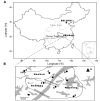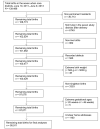Ambient Air Pollution and All-Cause and Cause-Specific Mortality in an Analysis of Asian Cohorts
- PMID: 37424069
- PMCID: PMC7266370
Ambient Air Pollution and All-Cause and Cause-Specific Mortality in an Analysis of Asian Cohorts
Abstract
Introduction: Much of what is currently known about the adverse effects of ambient air pollution comes from studies conducted in high-income regions, with relatively low air pollution levels. The aim of the current project is to examine the relationship between exposure to ambient air pollution (as predicted from satellite-based models) and all-cause and cause-specific mortality in several Asian cohorts.
Methods: Cohorts were recruited from the Asia Cohort Consortium (ACC). The geocoded residences of participants were assigned levels of ambient particulate material with aerodynamic diameter of 2.5 μm or less (PM2.5) and nitrogen dioxide (NO2) utilizing global satellite-derived models and assigned for the year of enrollment (or closest available year). The association between ambient exposure and mortality was established with Cox proportional hazard models, after adjustment for common confounders. Both single- and two-pollutant models were generated. Model robustness was evaluated, and hazard ratios were calculated for each cohort separately and combined via random effect meta-analysis for pooled risk estimates.
Results: Six cohort studies from the ACC participated: the Community-based Cancer Screening Program (CBCSCP, Taiwan), the Golestan Cohort Study (Iran), the Health Effects for Arsenic Longitudinal Study (HEALS, Bangladesh), the Japan Public Health Center-based Prospective Study (JPHC), the Korean Multi-center Cancer Cohort Study (KMCC), and the Mumbai Cohort Study (MCS, India). The cohorts represented over 340,000 participants.
Mean exposures to PM2.5 ranged from 8 to 58 μg/m3. Mean exposures to NO2 ranged from 7 to 23 ppb. For PM2.5, a positive, borderline nonsignificant relationship was observed between PM2.5 and cardiovascular mortality. Other relationships with PM2.5 tended toward the null in meta-analysis. For NO2, an overall positive relationship was observed between exposure to NO2 and all cancers and lung cancer. A borderline association between NO2 and nonmalignant lung disease was also observed. The findings within individual cohorts remained consistent across a variety of subgroups and alternative analyses, including two-pollutant models.
Conclusions: In a pooled examination of cohort studies across Asia, ambient PM2.5 exposure appears to be associated with an increased risk of cardiovascular mortality and ambient NO2 exposure is associated with an increased cancer (and lung cancer) mortality. This project has shown that satellite-derived models of pollution can be used in examinations of mortality risk in areas with either incomplete or missing air pollution monitoring.
© 2023 Health Effects Institute. All rights reserved.
Figures




Similar articles
-
Mortality and Morbidity Effects of Long-Term Exposure to Low-Level PM2.5, BC, NO2, and O3: An Analysis of European Cohorts in the ELAPSE Project.Res Rep Health Eff Inst. 2021 Sep;2021(208):1-127. Res Rep Health Eff Inst. 2021. PMID: 36106702 Free PMC article.
-
Mortality-Air Pollution Associations in Low Exposure Environments (MAPLE): Phase 2.Res Rep Health Eff Inst. 2022 Jul;2022(212):1-91. Res Rep Health Eff Inst. 2022. PMID: 36224709 Free PMC article.
-
Comparison of Long-Term Air Pollution Exposure from Mobile and Routine Monitoring, Low-Cost Sensors, and Dispersion Models.Res Rep Health Eff Inst. 2025 Mar;2025(226):1-101. Res Rep Health Eff Inst. 2025. PMID: 40405483 Free PMC article.
-
Assessing Adverse Health Effects of Long-Term Exposure to Low Levels of Ambient Air Pollution: Implementation of Causal Inference Methods.Res Rep Health Eff Inst. 2022 Jan;2022(211):1-56. Res Rep Health Eff Inst. 2022. PMID: 36193708 Free PMC article. Review.
-
Association between exposure to ambient air pollution and hospital admission, incidence, and mortality of stroke: an updated systematic review and meta-analysis of more than 23 million participants.Environ Health Prev Med. 2021 Jan 26;26(1):15. doi: 10.1186/s12199-021-00937-1. Environ Health Prev Med. 2021. PMID: 33499804 Free PMC article.
References
-
- Adams K, Eschenbach D. 2004. The genetic contribution towards preterm delivery. Semin Fetal Neonatal Med 9:445–452. - PubMed
-
- Andres R, Day M. 2000. Perinatal complications associated with maternal tobacco use. Semin Neonatol 5:231–241. - PubMed
-
- Angiolini E, Fowden A, Coan P, Sandovici I, Smith P, Dean W, et al. 2006. Regulation of placental efficiency for nutrient transport by imprinted genes. Placenta 27:S98–102. - PubMed
Publication types
MeSH terms
Substances
LinkOut - more resources
Full Text Sources
Medical
